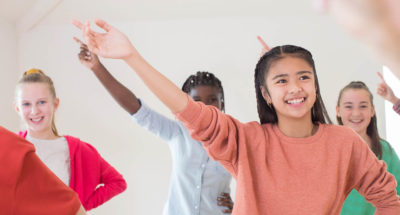
Getting to Know Each Other Through Dance
Students explore the idea of social engagement through both conversation and body language as they try a fun dance step and practice the art of “small talk” with one or several partners.

Students explore the idea of social engagement through both conversation and body language as they try a fun dance step and practice the art of “small talk” with one or several partners.
Students will:
Take a moment to reflect on how you use small talk and casual conversation to get to know people better. Is this easy or challenging for you?
EduMotion: SEL Journeys is a digital learning platform that integrates lessons on diversity, empathy and kindness with movement activities inspired by dances from around the world. EduMotion’s evidence-based curriculum has been used for more than a decade as a strategy to help students develop peer relationships and explore what it means to be a global citizen. Educators can get started by signing up for free dance-of-the-month content and SEL resources on edumotion.com
Were students able to respectfully engage in both movement and conversation? Which was harder for them? What could you do to build upon this experience next time?
In a study of 1st through 4th graders, teachers reported that dance and drama instruction contributed greatly to students’ social and emotional development.
In general, arts education has been found to increase students’ prosocial behavior, academic achievement, and positive self-concept, among other benefits.
Cultivating positive relationships between students is key to their academic success and well-being. Indeed, studies have found that peer acceptance relates positively to GPA in middle school and can explain up to 40% of adolescents’ academic achievement. In addition, positive peer relationships help to increase students’ resilience and self-esteem, and reduce their loneliness.
Programs that focus on cultural and social dance demonstrate that these kinds of dance experiences foster respect for others and collaboration across age, culture, and socioeconomic status.

Do you want to dive deeper into the science behind our GGIE practices? Enroll in one of our online courses for educators!
Comments